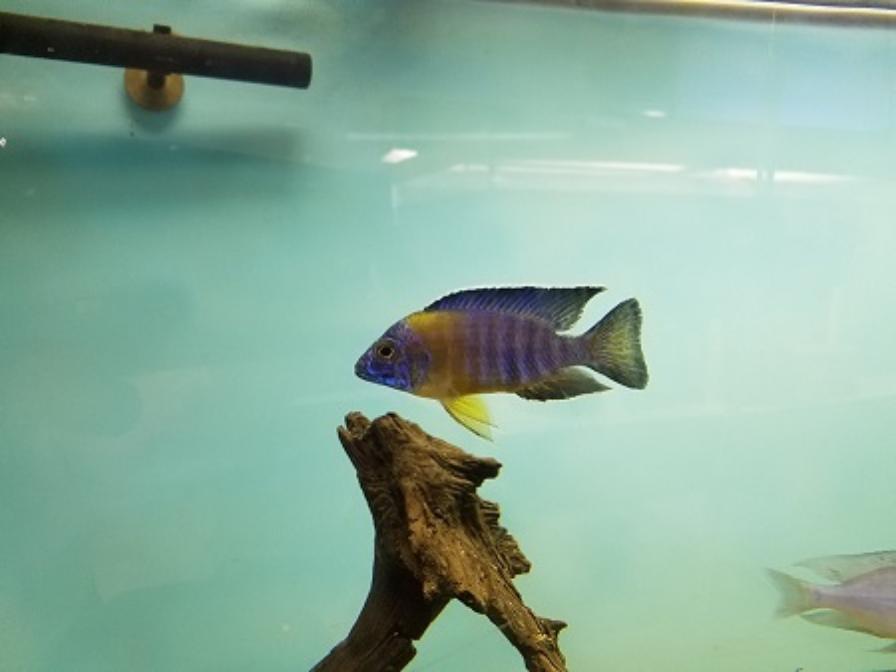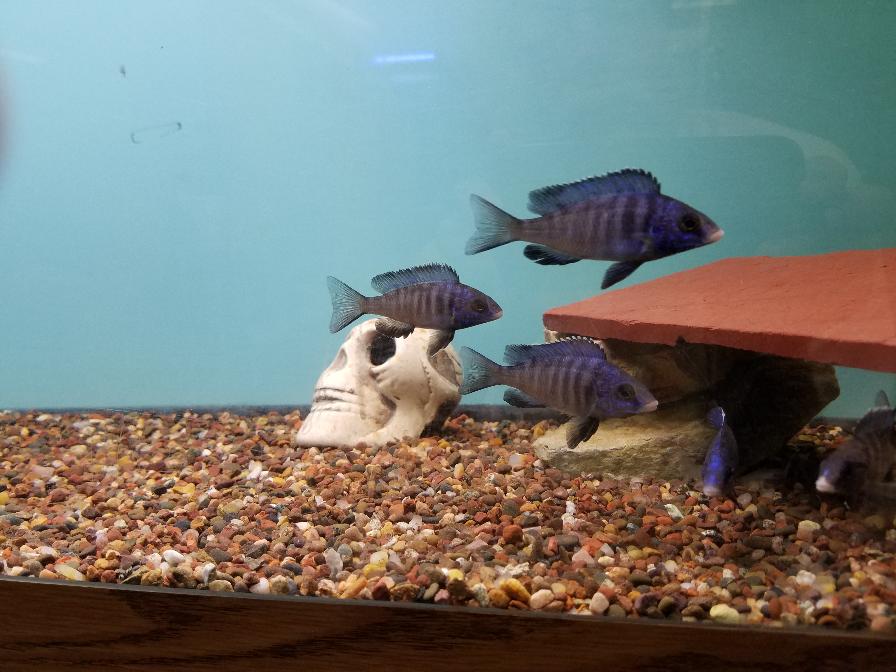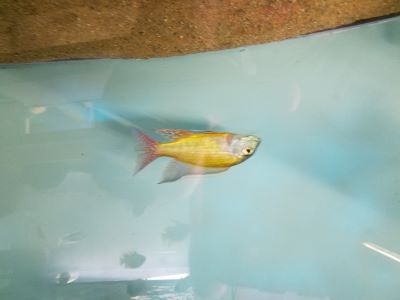CARE AND BREEDING OF SPECIFIC AFRICAN CICHLIDS


BI COLOR 500 AULONACARA MAULANA

DRAGONBLOOD PEACOCK
The pictures above show 2 examples. The first is an example of a common name along with the scientific name. The second picture is a hybrid species known as the Dragon Blood. As always there is controversy over just what were crossed but it is a pretty fish. Note that the eyes are not pink meaning it is not an albino. Many different species throw an albino now and again and many breeders seek to grow an albino trait fish. True albinos will have pink eyes, It is a recessive gene which crops up occasionally. It can be line bred to strengthen the number of pink off spring. A split gene fish carries the albino gene and will have pinks mixed in with the regular fry. I have a group of split gene Eurekas which has albino fry about 25% of the time. I will grow out the pinks and line breed them to strengthen the albino trait.
When it comes to cross breeding nature is better at it than we are. I recently had a pair of Sunshine peacocks in with a group of Copidichromis thinking the species were different enough to not hybrid. I got a group of fry and as they grew out their body shape became more round rather than elongated like an aulonacara. Then a large black vertical line appeared on their mid body. It appears that in spite of what I thought nature trumped me. Now I have cross breeds that will probably have no value. My curiosity will have me grow them out just to see what they look like but it won't be any break through at all. Best bet is when breeding keep the tank species specific, one tank and one type of fish.
NOT ALL THE SAME..... DIFFERENT STROKES
The entire group of peacocks, copidichromis or Metriclima may share anatomical aspects but just as in other animals each group takes on a group of habits individual to others. Sizes will vary some being smaller than others, tank terriories whether hiding in rocks or free swimming in open areas and tank mates will all change the parameters and thus actions. I have a group of full grown Tangerine Tigers which are Protomelas. After placing them alone in a 120g for breeding purposes they just disappeared. Every one had its own rock to hide under. I added 7 full grown Ngara peacocks and everyone came out to party. I have no idea if it is based on territory, aggression or just curiosity but they are now out and about. Hopefully this will also spur breeding activity in one or both groups. Yes there is a risk of hybrid so we will watch and see.
PLACIDICHROMIS PHENOCHILUS MDOKA "WHITE LIP"

One of the groups I have had the most success is pictured above. It is known as Placidichromis Phenochilis Mdoka "White Lip". As shown they do indeed have white lips. Another feature is that both male and female have the blue coloration. The males are more vivid. This is my group at under a year old and not fully mature. They live in a 4ft 55G species tank and to date have produced 600-800 fry. I guess this is the "perfect storm" for this particular group. They breed regularly, there is very little aggression and the survival rate for the fry is outstanding. I have other breeding groups that average 50% viable eggs yet these males seem to do their job well. They remain my most profitable breeders, very colorful and fun to watch. They are very strong jumpers. Tight lids for these guys.
THE LETHRINOPS FAMILY - COLORFUL DIGGERS

This group of fish resemble the Peacock family but lack the dark vertical barring. They will show some but after a while you will be able to distinguish between the species. The Lethrinops in the picture is known as Albus "Kande Island." The Kande Island is merely the area of the lake it resides in. Most females remain a steely gray and the dominant males shows different patterns of color depending on which Lethrinops it is. Currently I have the Albus, the Red Cap, the Gold Harbor Yellow Collar, and the sp. Orange Collar. These fish fascinate me because of their mid water swimming and excavation skills. The males dig a pit, sometimes a big one in the substrate and coax the female over to it to breed. Peacocks will do this also but these guys are the pros. They will move half the sand in your tank one mouthful at a time. They also sift sand for food so sand for a substrate is really necessary for their well being. their broods are rather large at times. They are aggressive only during breeding or real estate disputes but I have kept them successfully as a community fish with others their own size. I find all the types interesting and they are not as often seen as most of the peacocks which also attracts my attention for the harder to find types.
COPIDICHROMIS - PLACIDICHROMIS - OTOPHARNYX
THE HAPLACHROMIS FAMILY - EVER CHANGING
This group will make you wonder why you did not pay more attention in Latin
class in high school. Names change in this group like the weather in the Midwest. I have one fish that has had 3 names since I have owned it. Here I will discuss the ones I have personally raised. Many have "common names" which at first I thought was great since I opted for Spanish in school. Unfortunately suddenly the average hobbyist decided you don't need a knowledge of Latin to do this and began tagging fish with all manner of name. My take is stick to science and Latin. At least the rules do not change as much. However many folks only know the common name so you will have to deal with that. The other item here is hybrids or "designer" fish. The dog folks created a high priced cottage industry and the fish folks are right behind them. I do not deal in hybrids save one type because I am still learning Mother Natures group. Anyway off the soapbox and on to specifics.
OTOPHARNYX GROUP
This group has attracted the line breeders and hybrids. Let me explain the difference. "Line Breeding" is done by taking a particular breed of fish and raising multiple generations but only breeding with males that display a certain characteristic to enhance it further down the genetic highway. The BOD or Black Orange Dorsal would be an example. It is a Lithobates that has been bred to display a very dark body color with a striking orange blaze on the nose and dorsal thus the common name. It is not a hybrid but an enhancement of genetic features that already exist. The Z Rock which is actually named for Zimbabwe where the collection point is where the starting point is.
A hybrid is actually a cross between two different species to attain a different fish than either parent. This has become rampant in the hobby and is the beginning of many arguments both pro and con. Personally I avoid hybrids because they are very unpredictable, sometimes have fertility issues and depending on what is crossed can produce very feisty fish. It is certainly a personal choice.
This group is fairly wide spread but does not have a lot of members under the Otopharnyx moniker. They are all fairly colorful, most breed like crazy and are a fairly good community fish. They love rocks and like to hide so if they are in a species tank with caves and such they may only come out to eat. With other fish they move more. I now raise O. Auromarginatus which is a shy type and has fallen off my first choice list. The other venture has been the "Orange Black Dorsal" which I believe is a line bred fish rather than hybrid has become a "Hot Ticket" item. The dominant males are stunning and like all of their cousins have no problem in the breeding department.
THE PREDATOR GROUP
This group has become one I am pursuing. I have raised about 6 different types all of which are not real easy to breed. need a100g or more living space, and can take over 18 months to 2 years to sexually mature. My first and easiest attempt was Cheilochromis Euchilus or "Thick Lipped" cichlid. Grows to be a rather larger critter but both the males and females have eye popping features. The male goes into breeding mode and turns almost completely blue while the female retains her black lateral lines and yellowish tint. Another that I followed up with was the Aristochromis Christyi or Malawian Hawk. This guy has a rather sinister look more torpedo shaped with a pike type long snout. Again in breeding the male turns blue and female displays a body length black stripe. Both I had good success. The Nimbochromis Venustus was next on the list. Called the Giraffe Cichlis both sexes display giraffe like spotting with again blue as the male breed color. Of all these were the easiest breeders and fastest growers. Then I moved on to my latest project the Fossochromis Rostratus. By far my favorite and also the one that poses the biggest challenge at least for me. Both sexes have vivid vertical stripes but again the male transforms to the picture shown below. BTW the fish going out of frame on the right is a female Hawk. Fish is more impressive in person. My lighting is not photo friendly. It took a full 18 months to develop a group of 9. After that 2 males were picked and the rest moved. another few months and finally the breeding began. Within 2 months I had 100 fry. If there is any solace for the impatient all these fry types grow quickly and I have found are fairly sturdy. Once the fry are free swimming survival rates are good. A 6ft 220g tank with these types of fish in it is always a crowd pleaser. They are easily identifiable and active. Do not try these until you have a little experience and a LARGE tank. Well worth your time.
FOSSOCHROMIS ROSTRATUS AND FEMALE MALAWIAN HAWK
